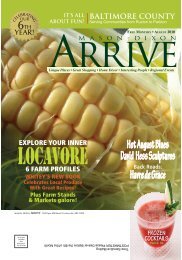baltimore county - Mason Dixon Arrive Magazine
baltimore county - Mason Dixon Arrive Magazine
baltimore county - Mason Dixon Arrive Magazine
Create successful ePaper yourself
Turn your PDF publications into a flip-book with our unique Google optimized e-Paper software.
libation<br />
By Kristin Heilman<br />
Opposite: Bodegas<br />
Protos in Peñafiel is now<br />
distributed in almost 100<br />
countries worldwide.<br />
Right: Ninety-nine percent<br />
of Cava is produced in<br />
the Penedès region of<br />
Cataluña, southwest of<br />
Barcelona.<br />
<br />
<br />
With vines introduced to its diverse landscape<br />
at least as far back as 300 B.C., Spain nurtures<br />
a deep tradition and passion for winemaking.<br />
Yet, only in recent years have Spanish wines<br />
made significant inroads to the American<br />
market, with imports soaring in the past<br />
decade. Admired for its innovative art and<br />
architecture, cutting-edge fashion and casual<br />
yet cultivated cuisine, Spain is quickly gaining<br />
the favor of wine connoisseurs worldwide.<br />
Since the late 20 th century, Spanish wines<br />
have experienced a renaissance, as the quality<br />
and diversity of the region’s wines have<br />
exploded. Young winemakers have led the<br />
revolution by marrying modern practices with<br />
honored traditions, wines and varietals. The<br />
result: complex and expressive wines that<br />
exude a keen sense of place.<br />
And place is paramount. Strict Spanish<br />
government regulation ensures a wine’s<br />
quality and character are consistent with its<br />
geographic roots. A designation system –<br />
Denominaciónes de Origén (D.O.) – identifies<br />
prestigious wines from specific regions,<br />
recognizing that the wine was sourced and<br />
produced according to certain parameters. If a<br />
label indicates D.O.C. – or Denominación de<br />
Origén Calificada – the wine has maintained<br />
superior quality over an extended period of<br />
time; Rioja and Priorat alone carry D.O.C.<br />
status.<br />
Spain currently has more than 70 D.O.s,<br />
allowing for a wide range of taste profiles.<br />
Easy to drink, affordable and widely available,<br />
these wines are food-friendly and complement<br />
cuisines ranging from Chinese and Thai to<br />
Mexican, Mediterranean and American. For<br />
consumers shopping for a bottle to enjoy with<br />
dinner, they’re in luck: most Spanish wines are<br />
ready to drink and don’t require cellaring.<br />
From crisp whites and soft rosés to deep<br />
reds and beyond, Spanish wines suit any occasion.<br />
Create an authentic tasting experience,<br />
and quaff a wine alongside simple Spanish<br />
tapas, such as Marcona almonds, marinated<br />
olives and artisan cheeses. As a bonus, cheese<br />
expert Michele Buster of Forever Cheese<br />
offers some pairing suggestions:<br />
For Special (or Not) Occasions:<br />
Cava<br />
Cava is Spain’s renowned sparkling<br />
wine and rivals the dry champagnes of<br />
France. It can only be produced in six<br />
wine regions – although 99 percent of<br />
Cava is produced in the Penedès region<br />
of Cataluña, southwest of Barcelona<br />
– and must rely on the traditional<br />
method (méthode champenoise). Like<br />
champagne, Cava has varying levels of<br />
dryness: brut nature, brut (extra dry),<br />
seco (dry), semiseco (medium) and dulce<br />
(sweet).<br />
Pairing: Sparkling wines typically<br />
have higher acidity and lower sugar<br />
levels than table wines, making them<br />
extremely versatile and food-friendly.<br />
Buster recommends a mild sheep’s milk<br />
cheese, such as Miticrema; a spreadable<br />
cream cheese; or a flavorful, citrusy soft<br />
ripened goat cheese, such as MitiCaña<br />
de Cabra.<br />
Spain’s Signature White: Albariño<br />
The Albariño grape, indigenous to<br />
Galicia in northwest Spain, is small and<br />
very sweet. Depending on the vintage<br />
and sub-region of D.O. Rías Baixas, this<br />
variety can be rich and expressive, with<br />
peach and apricot notes, or tart and bracing,<br />
like green apples and lemon peels.<br />
A high-quality, aromatic and crisp wine,<br />
Albariño pairs well with seafood dishes.<br />
Pairing suggestion: To coax the<br />
fullest flavor from Albariño, follow a<br />
sip with a nibble of goat cheese. Buster<br />
thinks a full-flavored raw milk goat<br />
cheese like Naked Goat pairs well given<br />
its slight tang in the finish. PataCabra,<br />
the product of a secret recipe using<br />
Muriciana goat’s milk, also provides a<br />
complex and well-balanced flavor profile<br />
that complements the wine.<br />
A Rosé by Another Name:<br />
Garnacha<br />
Garnacha is the third most planted<br />
grape in Spain and is concentrated in<br />
the country’s north central region. With<br />
origins in Spain, the variety traveled to<br />
southern France in the eighth and ninth<br />
centuries and is known as Grenache<br />
throughout the world.<br />
Pairing suggestion: Garnacha rosés<br />
have bright strawberry aromas with fresh<br />
cherry and currant flavors and traces<br />
of citrus and strawberry; crisp acidity<br />
is followed by a soft, round finish.<br />
Buster recommends matching it with<br />
a tangy, fruity cheese. Young Mahon,<br />
from young cow’s milk, is mild, fruity<br />
and versatile. A more complex option<br />
is Leonora, an exceptional goat cheese<br />
from León.<br />
The King of Reds: Tempranillo<br />
Known as the king of grapes in the<br />
Rioja region, Tempranillo is Spain’s classic<br />
varietal. A small, dark blackish-red<br />
grape, Tempranillo is widely admired for<br />
its vibrancy and variety. It is cultivated<br />
all over Spain, resulting in a great array<br />
of tastes reflective of Spain’s geographic<br />
diversity.<br />
Pairing suggestion: Expressive when<br />
young and velvety rich when aged,<br />
Tempranillo exhibits a spectrum of<br />
flavor, from hints of vanilla, cherries<br />
and currants to unexpected nuances<br />
of coconut. A buttery cheese such as<br />
Manchego is the ideal canvas for showcasing<br />
Tempranillo. Buster suggests<br />
Malvarosa, a smooth sheep’s milk cheese<br />
from Valencia.<br />
Not Your Grandmother’s Sherry<br />
Spanish sherry production is centered<br />
in southern Spain, where Palomino<br />
grape vines thrive in the chalky soil of<br />
the Jerez region. Though primarily produced<br />
from Palomino fruit, sherry may<br />
also incorporate Moscatel and Pedro<br />
Ximénez varietals.<br />
Fino Sherry is one of the driest<br />
and has a light, aperitif style. The<br />
palate is both salty and citrusy, with<br />
touches of green apple and almond.<br />
Often accompanying tapas, Fino<br />
Sherry balances with semi-firm goat<br />
cheeses. Buster suggests a Montcabrer<br />
from Catalunya for its creamy texture<br />
and earthy, slightly tangy taste,<br />
or Vare from Asturias, which has a<br />
creamy texture and the longest finish<br />
for a goat cheese.<br />
Sweet Sherry is sweetened with the<br />
juice of Pedro Ximénez grapes, which<br />
have high residual sugar content. Sundried<br />
to concentrate the sugars before<br />
being pressed, they lend thick, sweet<br />
flavors of fig and molasses to the final<br />
product. Appropriate for dessert or<br />
after dinner, sweet sherry fares well<br />
with blue cheeses. Look for Cabrales,<br />
which combines cow, sheep and goat<br />
milk in a potent, salty cheese, or the<br />
less assertive Valdeon, a mild, creamy<br />
cheese from cow and goat milk.<br />
Salud!<br />
28 <strong>Mason</strong>-<strong>Dixon</strong> ARRIVE | APRIL 2011 <strong>Mason</strong>-<strong>Dixon</strong> ARRIVE | APRIL 2011 29













